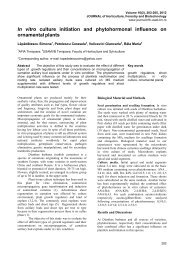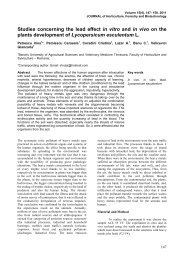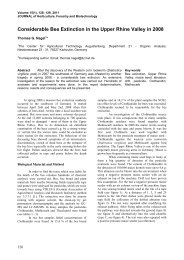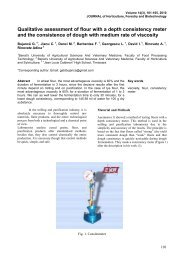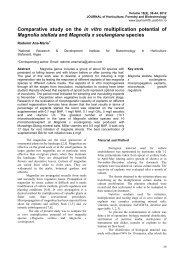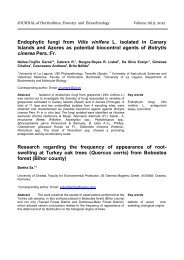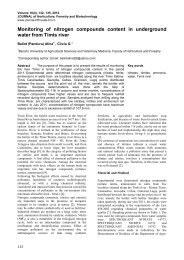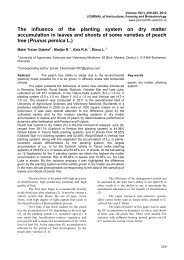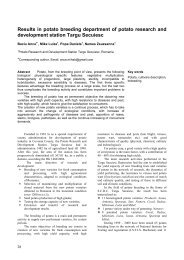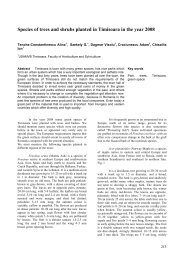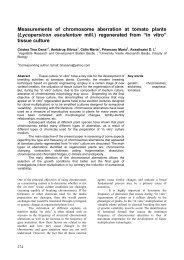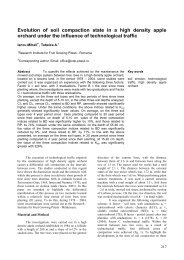Production of seedling tubers from true potato seed - Journal of ...
Production of seedling tubers from true potato seed - Journal of ...
Production of seedling tubers from true potato seed - Journal of ...
You also want an ePaper? Increase the reach of your titles
YUMPU automatically turns print PDFs into web optimized ePapers that Google loves.
Volume 16(4), 136- 141, 2012<br />
JOURNAL <strong>of</strong> Horticulture, Forestry and Biotechnology<br />
www.journal-hfb.usab-tm.ro<br />
<strong>Production</strong> <strong>of</strong> <strong><strong>seed</strong>ling</strong> <strong>tubers</strong> <strong>from</strong> <strong>true</strong> <strong>potato</strong> <strong>seed</strong> (TPS) in<br />
protected area<br />
Cioloca Mihaela 1* , Baciu Anca 2 , Nistor Andreea 1 , Popa Monica 1<br />
1 National Institute <strong>of</strong> Research and Development for Potato and Sugar Beet Brasov; 2 Potato Research and<br />
Development Station Târgu Secuiesc<br />
*Corresponding author. Email: mihaela.cioloca@<strong>potato</strong>.ro<br />
Abstract The <strong>potato</strong> (Solanum tuberosum) can be propagated both<br />
vegetatively (clonally) and sexually. True <strong>potato</strong> <strong>seed</strong> (TPS) technology is<br />
based on the natural ability <strong>of</strong> the <strong>potato</strong> to produce flowers, which are then<br />
fertilized and set berries that contain <strong>potato</strong> <strong>seed</strong>s, which will be used later as<br />
planting material. Initially, the main problem <strong>of</strong> <strong>potato</strong> hybrids derived <strong>from</strong><br />
<strong>true</strong> <strong>seed</strong> was related to the difficulty <strong>of</strong> producing uniform <strong>potato</strong>es in terms<br />
<strong>of</strong> shape, color, size and <strong>seed</strong> quality. Currently there are companies that<br />
produce <strong>true</strong> <strong>potato</strong> <strong>seed</strong>, rigorously tested qualitatively superior (free <strong>from</strong><br />
diseases and pests).<br />
Key words<br />
<strong>true</strong> <strong>potato</strong> <strong>seed</strong>, <strong><strong>seed</strong>ling</strong>s,<br />
mini<strong>tubers</strong>, greenhouse<br />
Because <strong>potato</strong>es are harvested, stored and<br />
replanted year after year, several pathogens can be<br />
transmitted by the vegetative multiplication <strong>of</strong> the crop<br />
and therefore the production is greatly affected. To<br />
achieve higher production, growers are able to<br />
purchase disease-free planting material <strong>from</strong><br />
authorized suppliers who apply the most rigorous<br />
methods for obtaining a healthy starting material.<br />
These are called “certified <strong>seed</strong> <strong>potato</strong>es”.<br />
Unfortunately, in many countries certified <strong>seed</strong> <strong>potato</strong><br />
may be available only through import. There is<br />
however a major drawback: because <strong>potato</strong> <strong>tubers</strong> are<br />
bulky, heavy and perishable, so transportation costs to<br />
import <strong>potato</strong>es and then deliver to the farmer are<br />
considerable. To solve this problem, researchers have<br />
tried to exploit the ability <strong>of</strong> <strong>potato</strong> plants to produce<br />
<strong>seed</strong>s. To distinguish these <strong>from</strong> "<strong>seed</strong> <strong>potato</strong>es" the<br />
<strong>seed</strong>s are called "<strong>true</strong> <strong>potato</strong> <strong>seed</strong>s" (TPS).<br />
Compared with the clonally propagation, TPS<br />
technology involves different operations, as a tuber<br />
weight is 70,000 bigger than a <strong>seed</strong>. A single tuber or a<br />
portion <strong>of</strong> it typically weighs 40 to 50 grams, but 40<br />
grams <strong>of</strong> TPS corresponds to approximately 56,000<br />
<strong>seed</strong>s. It takes only 160 grams <strong>of</strong> TPS to <strong>seed</strong> one<br />
hectare (compared to 2,000-3,000 kg <strong>of</strong> <strong>potato</strong> <strong>tubers</strong>),<br />
or 80 grams if <strong><strong>seed</strong>ling</strong>s are transplanted. Another<br />
advantage <strong>of</strong> TPS technology is that botanical <strong>seed</strong> is<br />
always available to be planted. Using <strong>true</strong> <strong>potato</strong> <strong>seed</strong><br />
has many advantages compared to the classic system.<br />
Based on these advantages, in 2005, the<br />
INCDCSZ Brasov initiated a series <strong>of</strong> experiments that<br />
were aimed at obtaining alternative planting material,<br />
biologically and phytosanitary appropriate, that can be<br />
a complement to <strong>seed</strong> requirements.<br />
Research methods and materials<br />
Using <strong>true</strong> <strong>potato</strong> <strong>seed</strong> we can obtain: mini<strong>tubers</strong>,<br />
<strong>seed</strong> or ware <strong>potato</strong>es. There are several ways to<br />
cultivate <strong>potato</strong>es based on TPS:<br />
direct <strong>seed</strong>ing in the field;<br />
breeding <strong><strong>seed</strong>ling</strong>s in protected areas,<br />
followed up by their transplanting in the field;<br />
cultivation in protected areas (<strong>from</strong> <strong>seed</strong>ing to<br />
tuber harvesting).<br />
The entire crop cycle was conducted in a protected<br />
area (greenhouse), at the National Institute <strong>of</strong> Research<br />
and Development for Potato and Sugar Beet Brasov<br />
(Center for Clonal Material <strong>Production</strong> for Potato<br />
Lazarea). Biologic material is represented by four<br />
isogenic <strong>potato</strong> lines: Mindy, Zolushka, Gilroy and<br />
Catalina provided by Bejo Zaden, Netherlands. The<br />
breeding <strong>of</strong> these lines is based on a <strong>potato</strong> research<br />
programme, aiming at promoting the varieties obtained<br />
<strong>of</strong> <strong>true</strong> <strong>potato</strong> <strong>seed</strong>, adaptable to the different climatic<br />
conditions in the different parts <strong>of</strong> the world.<br />
The properly stored <strong>seed</strong>s were sown in the<br />
greenhouse on germination beds, into a well-prepared<br />
soil free <strong>of</strong> large clumps. After placing <strong>seed</strong>s at high<br />
density (Fig. 1a), the <strong>seed</strong>ing depth being <strong>of</strong> 1 cm, they<br />
are covered with a thin layer <strong>of</strong> fine soil and sprinkled.<br />
An optimum sowing was provided, namely<br />
temperatures <strong>of</strong> 15º to 20 ºC and relative humidity <strong>of</strong><br />
air 60% to 80%.<br />
These small <strong>seed</strong>s have very little food reserves to<br />
maintain the developing <strong><strong>seed</strong>ling</strong> after germination.<br />
Therefore, this new technology requires different<br />
agronomic practices compared to a <strong>seed</strong> <strong>tubers</strong><br />
planting. Most important differences related to:<br />
- <strong>seed</strong> bed preparation,<br />
- pre-plant pesticide/herbicide and fertilizer application,<br />
- <strong>seed</strong> spacing,<br />
136
- depth placement<br />
- irrigation<br />
- post emergent fertilization<br />
- weed control.<br />
Most operations described above are characteristic<br />
to plant species with small <strong>seed</strong>s. Once the <strong><strong>seed</strong>ling</strong>s<br />
reach the age <strong>of</strong> 8 - 10 weeks, they can be treated as a<br />
common <strong>potato</strong> crop.<br />
The first <strong>true</strong> leaves began to appear 2 weeks after<br />
sowing. At the end <strong>of</strong> its emergence, preventive<br />
treatments were made against late blight using Ridomil<br />
Gold (systemic fungicide).<br />
a b c d<br />
Fig.1 Sowing and harvesting <strong>potato</strong> mini<strong>tubers</strong><br />
After 4-8 weeks <strong>from</strong> sowing, when the <strong><strong>seed</strong>ling</strong>s<br />
were about 5-10 cm height (Fig. 1b), these were<br />
transplanted into pots with tapered form with the<br />
following characteristics: large base diameter 10 cm,<br />
small base diameter 7 cm, height 9 cm (Fig. 1c).<br />
During the vegetation treatments were applied -<br />
fungicide (Ridomil Gold) with insecticide (Mospilan)<br />
approximately every 3 weeks. Complex fertilizer NPK<br />
15 15 15 was also used in the form <strong>of</strong> granules applied<br />
to the soil surface. Appropriate conditions <strong>of</strong> light,<br />
temperature and humidity were provided for the<br />
harmonious growth <strong>of</strong> plants.<br />
During the vegetation period <strong>potato</strong> plants were<br />
cared for like other vegetables grown in protected area.<br />
The following aspects were taken into account:<br />
-ensuring optimal growth conditions (temperature,<br />
humidity, light, substrate quality);<br />
-adequate and timely fertilizer applications (in the soil<br />
and/or foliage);<br />
-effective control <strong>of</strong> pests and diseases.<br />
About 175 days after planting, the <strong>tubers</strong> that have<br />
reached full maturity were harvested (Fig. 1d). Two<br />
weeks before harvest chemical haulm destruction was<br />
carried out to reduce losses caused by uneven<br />
maturation <strong>of</strong> <strong>tubers</strong>. This technique is indicated in<br />
TPS technologies, considering that progenies derived<br />
<strong>from</strong> <strong>true</strong> <strong>potato</strong> <strong>seed</strong> are made up <strong>of</strong> individuals with<br />
different genotypes, which can lead to some<br />
differences regarding tuber maturation. Each plant was<br />
harvested separately in labeled paper bags. Shortly<br />
after harvest, all <strong>tubers</strong> were analyzed individually,<br />
aiming at uniformity <strong>of</strong> first vegetative generation.<br />
Results and Discussions<br />
In the TPS technology the main barrier, but<br />
also a challenge for science is the production <strong>of</strong> <strong>seed</strong>s<br />
that produce uniform <strong>tubers</strong> despite the great genetic<br />
variability <strong>of</strong> <strong>potato</strong>. Potato plants obtained <strong>from</strong><br />
botanical <strong>seed</strong> have genetic characteristic completely<br />
different <strong>from</strong> those <strong>of</strong> the parents in terms <strong>of</strong><br />
phenotype, maturity group and tuber characteristics.<br />
These features <strong>of</strong> the heterozygote are considered<br />
major disadvantages <strong>of</strong> <strong>potato</strong> hybrid progenies. But on<br />
the other hand, there is the advantage <strong>of</strong> variability in<br />
the population, which makes it less vulnerable to the<br />
action <strong>of</strong> natural selection than clonal varieties (yield,<br />
pest and disease resistance, adaptability to different<br />
environmental conditions).<br />
When working with <strong>true</strong> <strong>potato</strong> <strong>seed</strong>, one <strong>of</strong><br />
the most important pursued aspects is the analysis <strong>of</strong><br />
the uniformity <strong>of</strong> the first vegetative generation. In this<br />
experience, after harvesting mini<strong>tubers</strong> for each <strong>of</strong> the<br />
four genotypes, plants were individually marked in<br />
terms <strong>of</strong> the following characteristics: number <strong>of</strong><br />
<strong>tubers</strong>/plants, skin colour, eye depth. Furthermore,<br />
observations were made on <strong>seed</strong> germination and<br />
<strong><strong>seed</strong>ling</strong> survival rate after transplanting, depending on<br />
genotype.<br />
The first <strong>true</strong> leaves appeared about 2 weeks after<br />
sowing. Regarding the dynamics <strong>of</strong> <strong>potato</strong> <strong><strong>seed</strong>ling</strong>s<br />
emergence, the best results were registered in the case<br />
<strong>of</strong> Zolushka and Gilroy (Fig.2).<br />
137
%<br />
120,00<br />
100,00<br />
80,00<br />
60,00<br />
40,00<br />
20,00<br />
0,00<br />
Data<br />
Mindy Zolushka Catalina Gilroy<br />
Fig.2. The dynamics <strong>of</strong> <strong>potato</strong> plantlets emergence<br />
Seeds germinated in percentage <strong>of</strong> 96.4% and 98.7%<br />
respectively, in a short time (10 days <strong>from</strong> sowing) and<br />
<strong><strong>seed</strong>ling</strong>s were vigorous (Table 1). About a month and<br />
a half after sowing, the <strong><strong>seed</strong>ling</strong>s were transplanted<br />
into pots. Regarding the survival rate <strong>of</strong> <strong><strong>seed</strong>ling</strong>s<br />
following transplanting, the Gilroy line was noted<br />
again, recording the best percentage (89.18%).<br />
Table 1<br />
Line<br />
Data on the initiation <strong>of</strong> <strong>potato</strong> crop and <strong><strong>seed</strong>ling</strong>s trasplanting<br />
Emergence<br />
percentage (%)<br />
Seedlings vigour<br />
Survival rate following<br />
transplanting (%)<br />
MINDY 87,2 satisfactory 79,81<br />
ZOLUSHKA 96,4 very good 77,17<br />
GILROY 98,7 very good 89,18<br />
CATALINA 74,7 good 83,03<br />
On the average number <strong>of</strong> <strong>tubers</strong>/plant (Fig.<br />
3), the best results were obtained in the case <strong>of</strong><br />
Catalina line (3.53), followed by Mindy (3.22), Gilroy<br />
(3.08) and Zolushka (2.71).<br />
Fig.3 Comparing the average number <strong>of</strong> <strong>tubers</strong>/plant in studied lines<br />
It can be seen that, between the lines Mindy,<br />
Gilroy and Zolushka there are no significant<br />
differences in the average number <strong>of</strong> <strong>tubers</strong>/plant,<br />
while the Catalina is significantly different <strong>from</strong><br />
Zolushka (Fig.3).<br />
For characterization <strong>of</strong> <strong>potato</strong> genotypes in<br />
terms <strong>of</strong> the eyes depth, we used a 1 to 5 rating scale,<br />
as follows: shallow eyes (1), semi-superficial (2),<br />
medium depth (3), deep (4) and very deep (5).<br />
Regarding this character, unlike the others, for<br />
statistical interpretation <strong>of</strong> the results we used Chi 2<br />
tests and we noted that there are no significant<br />
differences between the studied genotypes (Fig. 4).<br />
138
Fig.4 Comparing studied lines regarding depth eyes<br />
It is noted that in all four studied genotypes<br />
shallow eyes <strong>tubers</strong> predominate. This feature is<br />
important for fresh consumption and <strong>potato</strong><br />
industrialization. Tubers with thin skin and shallow<br />
eyes have minimal peeling loss (10% to 12%), while<br />
varieties with thick skin and deep eyes reach 25%.<br />
Regarding the average weight <strong>of</strong> <strong>tubers</strong>, using<br />
Duncan test, the four lines were divided into three<br />
homogeneous subsets (Fig. 5).<br />
Fig.5 Comparing the average weight <strong>of</strong> <strong>tubers</strong> <strong>from</strong> studied lines<br />
139
Thus the lowest value was recorded in the<br />
case <strong>of</strong> Catalina (6.01 g), in an intermediate position is<br />
the Mindy (8.11 g) and the best results were registered<br />
at Zolushka (10.09 g) and Gilroy (9.66 g), with no<br />
significant differences, but Zolushka differs<br />
significantly <strong>from</strong> Catalina.<br />
On total average weight <strong>of</strong> <strong>tubers</strong>/plant, the<br />
best results were obtained in the case <strong>of</strong> Gilroy (24.50<br />
g), followed by the Zolushka (21.35 g), Mindy (20.77<br />
g) and Catalina (18.16 g). Using the Duncan test the<br />
four lines were grouped into three subsets. It can be<br />
observed that between Zolushka and Mindy there are<br />
no significant differences regarding the total average<br />
weight <strong>of</strong> <strong>tubers</strong>/plant, but the Gilroy differs<br />
significantly <strong>from</strong> Catalina (Fig. 6).<br />
Fig.6 Comparing the total average weight <strong>of</strong> <strong>tubers</strong>/plant <strong>from</strong> studied lines<br />
In the case <strong>of</strong> all four studied genotypes, the<br />
plants were uniform in terms <strong>of</strong> skin color, <strong>tubers</strong><br />
having white skin.<br />
Conclusions<br />
In the TPS technology the main barrier, but also a<br />
challenge for science, is the production <strong>of</strong> <strong>seed</strong>s that<br />
produce uniform <strong>tubers</strong> despite the great genetic<br />
variability <strong>of</strong> <strong>potato</strong>. From botanical <strong>potato</strong> <strong>seed</strong> can be<br />
obtained: mini<strong>tubers</strong>, <strong>seed</strong> or ware <strong>potato</strong>es. There are<br />
many possibilities to grow <strong>potato</strong>es <strong>from</strong> <strong>true</strong> <strong>seed</strong>:<br />
Sowing directly at well-defined distances<br />
<strong>from</strong> the beginning, and harvesting the <strong>tubers</strong> for<br />
consumption (larger) and/or <strong>seed</strong> <strong>potato</strong>es (smaller);<br />
Sowing at higher densities in <strong>seed</strong>beds and<br />
harvesting mini<strong>tubers</strong> (small size) and <strong>seed</strong> <strong>tubers</strong><br />
(larger size);<br />
Growing <strong><strong>seed</strong>ling</strong>s and then transplanting<br />
them at high density to produce mini<strong>tubers</strong> or <strong>seed</strong><br />
<strong>potato</strong>es;<br />
Growing <strong><strong>seed</strong>ling</strong>s and then transplanting<br />
them to produce <strong>potato</strong>es for consumption.<br />
Currently are sold large amounts <strong>of</strong> <strong>potato</strong>es<br />
produced <strong>from</strong> TPS, both for consumption and as<br />
planting material but also for industrialization. In many<br />
regions around the world, recently even in our country,<br />
consumers show an important interest in so-called<br />
"baby <strong>potato</strong>es". They are willing to pay a high price<br />
for these small <strong>tubers</strong> grown <strong>from</strong> <strong>true</strong> <strong>potato</strong> <strong>seed</strong>.<br />
In protected area conditions the Zolushka and<br />
Gilroy behaved the best. Botanical <strong>potato</strong> <strong>seed</strong> <strong>from</strong><br />
both lines had the highest percentage <strong>of</strong> germination<br />
98.7% and 96.4% respectively, in a short time (10 days<br />
<strong>from</strong> sowing) and the <strong><strong>seed</strong>ling</strong>s obtained were very<br />
vigorous. The Gilroy was remarked also for the<br />
positive behavior <strong>of</strong> <strong><strong>seed</strong>ling</strong>s after transplanting.<br />
On the average number <strong>of</strong> <strong>tubers</strong>/plant, the best<br />
results were obtained at Catalina (3.53) followed by<br />
Mindy (3. 22).<br />
The total average weight <strong>of</strong> <strong>tubers</strong>/plant was 21 g.<br />
Gilroy is on the first place with an average <strong>of</strong> 24.5 g,<br />
followed by Zolushka with 21.35 g. The average<br />
weight <strong>of</strong> <strong>tubers</strong> varied between 6.01 g in the case <strong>of</strong><br />
Catalina and 10.09 g in the case <strong>of</strong> Zolushka.<br />
There were no significant differences between the<br />
studied genotypes regarding the eyes depth. It notes,<br />
however, that the largest share had plants which <strong>tubers</strong><br />
with shallow eyes. At all the four studied genotypes the<br />
plants were uniform in terms <strong>of</strong> skin color, <strong>tubers</strong><br />
having white skin.<br />
References<br />
1.Adhikari R.C., 2010. True <strong>potato</strong> <strong>seed</strong> for<br />
commercial <strong>potato</strong> production and food security in<br />
140
Nepal. Proceedings <strong>of</strong> the Potato AgroPhysiology.<br />
Nevsehir, Turkey,<br />
2.Adhikari R.C., Rai G.P., Upreti K.C., Gautam I.P.,<br />
Chaudhary D.K., Chapagain T.R., Bhandari K.B.,<br />
2004. 3.Evaluation <strong>of</strong> <strong>true</strong> <strong>potato</strong> <strong>seed</strong> families for<br />
<strong><strong>seed</strong>ling</strong> tuber production in Nepal, p. 158-166. In:<br />
Proceedings <strong>of</strong> the Fourth National Horticulture<br />
Workshop, 2-4 March 2004. Nepal Agricultural<br />
Research Council National Agriculture Research<br />
Institute and Horticulture Research Division,<br />
Khumaltar. p. 216-223.<br />
4.Almekinders C.J.M., Chujoy E., Thiele G., 2009. The<br />
use <strong>of</strong> <strong>true</strong> <strong>potato</strong> <strong>seed</strong> as pro-poor technology: the<br />
efforts <strong>of</strong> an International Agricultural Research<br />
Institute to innovating <strong>potato</strong> production. Potato<br />
Research, 52: 275-293.<br />
5.Bozeşan I., Prodan M., 2003. Utilizarea seminţei<br />
botanice – o alternativă a asigurării necesarului de<br />
material de plantat la cart<strong>of</strong>. Cart<strong>of</strong>ul în Romănia, vol.<br />
13, nr. 4.<br />
6.Carlson H.L., Kirby D., 2005. Development <strong>of</strong><br />
cultural techniques for production <strong>of</strong> baby <strong>potato</strong>es.<br />
Research progress, no. 110. University <strong>of</strong> California<br />
Intermountain Research and Extension Center,<br />
Tulelake, California.<br />
7.Chujoy E., Cabello R., 2007. The Canon <strong>of</strong> Potato<br />
Science: 29. True <strong>potato</strong> <strong>seed</strong> (TPS). Potato Research<br />
50: 323-325.<br />
8.Cioloca Mihaela, 2011. Cercetări privind<br />
comportarea unor genotipuri de cart<strong>of</strong> rezultate prin<br />
înmulţire generativă cu privire la performanţele de<br />
producţie, calitate şi uniformitate. Teză de doctorat,<br />
Universitatea de ştiinţe Agricole şi Medicină<br />
Veterinară a Banatului din Timişoara.<br />
9.Fuglie K.O., 2001. Performance and prospects <strong>of</strong><br />
hybrid <strong>true</strong> <strong>potato</strong> <strong>seed</strong> in south and southeast Asia.<br />
Proceedings <strong>of</strong> the CIP-ADB Symposium "Field-<br />
Testing Hybrid TPS in the Lowland Tropics <strong>of</strong> Asia",<br />
Bogor, Indonesia.<br />
10.Gopal J., 2004. True <strong>potato</strong> <strong>seed</strong>: breeding for<br />
hardiness. Proceedings <strong>of</strong> the Sixth Triennial Congress<br />
<strong>of</strong> the African Potato Association, Agadir, Morocco 5-<br />
10 April 2004, p. 39-57.<br />
11.Nazirzadeh A., Hassanpanah D., Yildiz M., Celal<br />
E., 2010. Analysis <strong>of</strong> quantitative and qualitative<br />
properties <strong>of</strong> base <strong>seed</strong>s <strong>from</strong> <strong>true</strong> <strong>potato</strong> <strong>seed</strong>s (TPS).<br />
Proceedings <strong>of</strong> the Potato AgroPhysiology. Nevsehir,<br />
Turkey, p. 210-215.<br />
12.Pande P.C., Girish B.H., Kadian M.S., Ilangantileke<br />
S.G., 2003. Evaluation <strong>of</strong> <strong>true</strong> <strong>potato</strong> <strong>seed</strong> families for<br />
adaptability and yield characteristics. <strong>Journal</strong> <strong>of</strong> the<br />
Indian Potato Association, vol. 30 (1-2).<br />
141



